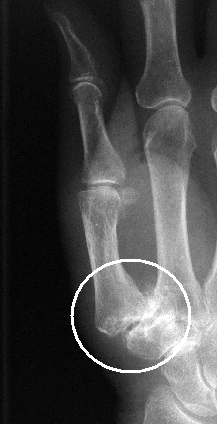What is osteoarthritis?
A condition which results in destruction of a joint is termed arthritis. Osteoarthritis is the most common type of arthritis and it is often referred to as degenerative joint disease or 'wear and tear'. Normal joints are lined by cartilage which allows the bones to move smoothly over each other. In osteoarthritis this layer of cartilage is thinned or absent resulting in joint stiffness, swelling and pain.
Basal thumb osteoarthritis:
The joint at the base of the thumb is very mobile which enables the thumb to have a large range of movement. Painless movement at this joint is important for normal function as it is our ability of to use our thumb so effectively that distinguishes us from other animals. This joint allows us to move our thumb so that it can touch the little finger (thumb opposition), something that is unique to humans. The basal thumb joint (also known as the 1st carpometacarpal joint) is 'saddle' shaped and formed by a small bone called the trapezium and the thumb metacarpal bone (figure 1). Arthritis of the base of the thumb is more common in women typically occuring over the age of 40. The presence of arthritis does not always cause any symptoms.

Figure 1: osteoarthritis of the basal thumb joint (carpometacarpal joint or CMCJ).
You can see loss of the joint space which is irregular and deformed
Symptoms and signs:
Pain at the base of the thumb is typical. Patients often describe a background ache felt at the base of the thumb that is present most of the time. This pain is worse with thumb pinch activities such as opening a jar, turning keys, lifting heavy saucepans or kettles. Loss of movement of the thumb is often present but this is not always noticed by the patient. Some people notice that there is a 'grinding' or 'cracking' sensation with thumb movement (crepitus)
Your doctor will usually be able to make the diagnosis after examining you. An x-ray will confirm the diagnosis.
Treatment:
Non-surgical
Many people respond well to non-surgical treatment using the following;
-
activity modification and rest
-
analgesia medication (especially anti-inflammatory medication, if tolerated)
-
thumb splint
-
steroid injection into the joint
Surgical
Those patients whose symptoms remain troublesome after non-surgical treatment can consider surgery. There are several surgical procedures that have been described, but the gold standard operation is to remove the trapezium bone. Some surgeons will also use part of a wrist tendon to reconstruct the thumb ligaments and provide a mass of tissue to fill the space where the bone has been removed. You will have the opportunity to discuss which operation is most suited to you with your surgeon.
The surgery can be performed as a day case procedure using regional anaesthesia where the limb is paralysed and anaesthetised temporarily. Postoperatively, many surgeons immobilise the thumb in a plaster cast for 6 weeks before mobilisation is commenced. Surgery is usually successful at removing the thumb pain whilst maintaining thumb mobility.
Surgical complications are fortunately uncommon but include:
-
infection (approximately 1%)
-
temporary scar tenderness
-
numbness or sensitivity over the back of the thumb
-
finger stiffness